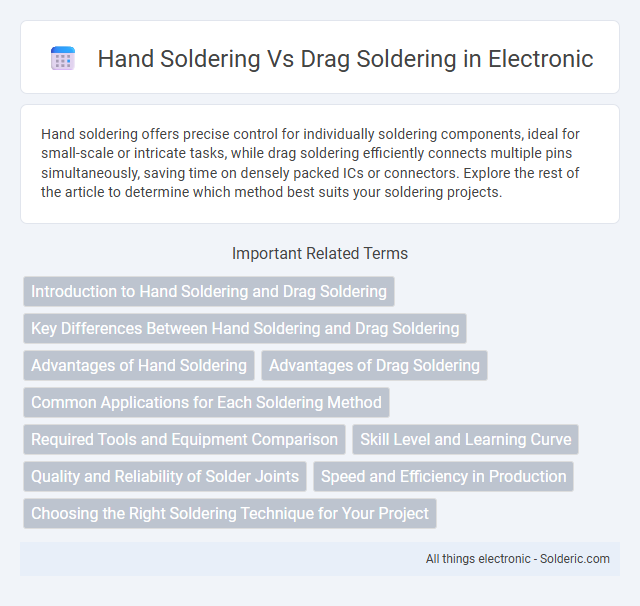Hand soldering offers precise control for individually soldering components, ideal for small-scale or intricate tasks, while drag soldering efficiently connects multiple pins simultaneously, saving time on densely packed ICs or connectors. Explore the rest of the article to determine which method best suits your soldering projects.
Comparison Table
| Feature | Hand Soldering | Drag Soldering |
|---|---|---|
| Definition | Manual soldering with a fine-tipped iron for individual components. | Soldering technique using a broad-tip iron to drag solder along multiple pins. |
| Speed | Slower, suitable for precise work and single joints. | Faster for soldering multiple adjacent pins simultaneously. |
| Use Case | Ideal for through-hole components and single-pin soldering. | Best for surface-mount devices (SMD) with fine-pitch pins. |
| Skill Level | Moderate; requires steady hand and attention to detail. | Advanced; demands experience to avoid solder bridges. |
| Solder Quality | Precise joints with minimal risks of bridging. | Potential for solder bridges if not done carefully. |
| Tools Required | Fine-tip soldering iron, solder wire, tweezers. | Broad or chisel-tip soldering iron, flux, solder wick. |
| Common Applications | Repair, prototyping, detailed component placement. | Batch soldering of SMD IC pins, fine-pitch QFPs. |
Introduction to Hand Soldering and Drag Soldering
Hand soldering and drag soldering are two essential techniques used in electronics assembly and repair, each suitable for different types of components and circuit boards. Hand soldering uses a fine-tipped soldering iron to apply solder precisely to individual joints, ideal for through-hole and small surface-mount components. Drag soldering involves dragging a soldering iron tip with solder across closely spaced pins, efficiently soldering fine-pitch surface-mount components and saving time on dense circuit boards.
Key Differences Between Hand Soldering and Drag Soldering
Hand soldering involves carefully applying solder to individual joints using a fine-tipped soldering iron, allowing precise control for intricate work on components such as through-hole and small surface-mount devices. Drag soldering uses a wider soldering tip coated with solder, which is dragged across multiple pins simultaneously, significantly speeding up the process for closely spaced surface-mount components like quad flat packages (QFPs). The key differences lie in precision and speed: hand soldering offers meticulous control for single joints, while drag soldering enhances efficiency for bulk soldering on compact pin arrays.
Advantages of Hand Soldering
Hand soldering offers precise control over the soldering process, making it ideal for delicate components and intricate circuit boards. This technique reduces the risk of solder bridges and damage to nearby parts, ensuring higher-quality connections. Skilled technicians can easily adjust heat and solder application, resulting in reliable and durable joints.
Advantages of Drag Soldering
Drag soldering offers significant advantages over hand soldering when working with densely packed surface-mount components, enabling faster and more consistent solder joints. This technique reduces the risk of bridging and overheating individual pins by allowing continuous soldering along component rows, improving thermal efficiency and joint reliability. Drag soldering also minimizes manual dexterity requirements, making it ideal for complex assemblies and large production runs.
Common Applications for Each Soldering Method
Hand soldering is commonly used for precision tasks such as repairing delicate electronic components, prototyping circuit boards, and assembling small-scale projects requiring detailed control. Drag soldering is widely applied in mass production environments for soldering surface-mount device (SMD) pads efficiently, particularly on printed circuit boards (PCBs) with fine-pitch components. Manufacturers prefer drag soldering for arrayed ICs and densely packed boards where speed and consistency are critical.
Required Tools and Equipment Comparison
Hand soldering requires a soldering iron, solder wire, flux, and often a helping hand tool or tweezers for precise component placement, making it ideal for individual or small-scale tasks. Drag soldering uses a broader tip soldering iron or specialized drag soldering iron and flux-cored solder, allowing solder to be applied to multiple pins simultaneously, suitable for fine-pitch surface-mount devices. Both methods demand temperature control and appropriate safety gear, but drag soldering reduces time and complexity for densely packed components compared to the more meticulous hand soldering process.
Skill Level and Learning Curve
Hand soldering demands fine motor skills and precise control, making it more suitable for users with some prior experience or those willing to invest time developing steady hand movements. Drag soldering, while faster for connecting multiple pins simultaneously, requires a nuanced understanding of solder flow and temperature control to avoid bridging or damaging components. Your learning curve with hand soldering may be steeper initially, but it offers greater precision for detailed work, whereas drag soldering is efficient once you master its technique.
Quality and Reliability of Solder Joints
Hand soldering offers precise control, resulting in high-quality solder joints with minimal risks of bridging or cold joints, making it ideal for intricate electronic components. Drag soldering, while faster for soldering multiple pins simultaneously, requires skill to maintain consistent heat and avoid solder bridges or insufficient wetting, which can affect joint reliability. Both methods can produce reliable connections when performed correctly, but hand soldering generally provides superior quality in delicate or complex assemblies.
Speed and Efficiency in Production
Hand soldering offers precise control ideal for delicate, low-volume work but is slower and less efficient for mass production. Drag soldering employs a continuous soldering iron motion along joint rows, significantly increasing throughput and reducing production time. This technique enhances efficiency by minimizing manual repositioning and heat application, making it optimal for larger-scale electronics manufacturing.
Choosing the Right Soldering Technique for Your Project
Hand soldering provides precise control for detailed work on individual components, making it ideal for repairs and prototypes. Drag soldering efficiently joins multiple pins on surface-mount devices, saving time on densely packed circuit boards. Selecting the right soldering technique depends on your project's complexity, component layout, and desired accuracy.
hand soldering vs drag soldering Infographic

 solderic.com
solderic.com